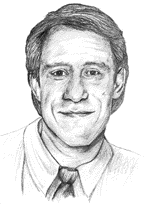 |
Traders should know that many of their hoary aphorisms are taking on bone and muscle as academics flesh out the concepts of behavioral finance (see STOCKS & COMMODITIES' March 2000 interview with financial behavioralist Hersch Shefrin) with solid research. While their work hasn't yet led to a unified theory, a working confirmation of the existence of crowd psychology is taking shape.
Individual foibles crop up in money managers both large and retail: not taking losses; excessive trading; overconfidence in interpreting events; representativeness; hanging the word "technology" on a share and trading on that affiliation; and anchoring -- using external benchmarks to make decisions -- in this case, past prices. Until the market correction of this past spring, people traded then-current prices as though fundamentals had no relation to the money they were shelling out, simply because those were the prices that others were paying.
Another form of anchoring: price charts, which capture how people judge the price they should pay by the prices that have been paid. Since evidence is accumulating that we stay with the crowd, charts acquire a certain credibility as being at least one way to picture our tendency to anchor. Plus, if most are anchoring to recent price movement, haven't we just defined herd behavior? Even academics have been caught using the term. Now we only need to study how a herd turns.
Boom and bust? Charles Lee and Bhaskaran Swaminathan of Cornell University have shown how volume correlates with earnings surprises, subsequent price reversals and price momentum. Could this be another herd effect?
How about fear and greed? Cheekiat Low, a Yale professor, published a paper showing that volatility rises as prices decline (fear) but actually declines as prices rise. He (and Federal Reserve chairman Alan Greenspan) was kind enough to call it "exuberance." I took it as evidence that most market players are investors, not traders who should be able to swim as ably downward as upward.
Professionals studying these results have already started to make decisions -- with computers. Rather than let decisions be susceptible to human foibles, objective standards -- what we would call mechanical systems -- are employed in the screening, selection, buying, and selling of tradables. This, of course, is not new to readers of S&C. It may be comforting to know that our oft-advised approach now has more behind it than "eliminating emotions"!
Though most of us trade prices, our distance, our computers, our models, and our newsfeeds often make us forget the humans on the other side of the trade. Prices aren't seen as sweat but cool, green numbers on a black background. Even trading the Deutsche Terminbourse, there are humans on the other side, all equipped with the same foibles. We're getting a better picture of those traits, but in the action, don't think of it as mano a mano, but as mano a many.